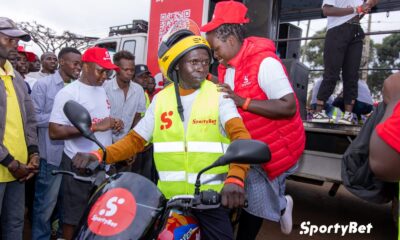Nairobi — Natiira Ateni Self Help Group was formed in August 2014. The group was formed by former pastoralists who had lost their livelihoods after losing their cattle during frequent cattle rustling raids by the Toposas of South Sudan. Wycliffe Juma, the monitoring and evaluation officer at CEZAM has overseen the development and rollout of the project since 2017.
allAfrica‘s Nancy Onyango talks to Juma about Natiira Ateni, a community that has since transitioned from pastoralism to crop farming. (allAfrica’s interviews are edited for clarity and length)
How did Natiira Self Help Group start?
Natiira Ateni Self Help Group was formed as a savings group. The group was formed by former pastoralists who had lost their livelihoods after losing their cattle during frequent raids by the Toposas of South Sudan and other neighbouring tribes from Pokot and Samburu county.
In 2014, the Kenyan government began training pastoralists in agriculture as an alternative to rearing livestock through the ministry of agriculture. Natiira Ateni self help group was one of the groups that was lucky to be trained. After the training they began practicing rain fed agriculture which was not sustainable. Turkana county is an arid area with only two to three months of rain every year. The drought destroyed their crops and they began seeking support to ensure all year supply of water in their farms.
Natiira applied for a grant of KES. 9,544.707 from USADF which they got and helped them address their challenges. They drilled and equipped a borehole and also set up a drip irrigation system which ensured they get regular water supply throughout the year for crop production using the drip irrigation system.
Insecurity is rampant in Turkana county. Why is this so?
Turkana is surrounded by three countries which are currently conflict hotspots, Uganda to the west, Ethiopia and South Sudan to the north. To its south and east, Turkana is surrounded by neighbouring counties such as Samburu, Baringo and West Pokot. Both the neighbouring countries and counties have pastoralists. The insecurity is being brought on by the fact that cattle rustling is an accepted practise and cattle rustling is usually a bloody exercise in the sense that people raid other counties or other countries with guns so as to get livestock for paying dowry and for wealth. Cattle rustling is an out-dated practise but unfortunately it’s still accepted in Turkana county and the neighbouring countries which have pastoralists.
What impact does the Kakuma refugee camp have on the project?
Kakuma town and Kakuma Refugee Camp are 20 kilometres away from the Natiira irrigation project. Kakuma Refugee Camp is one of the biggest refugee camps in Kenya and it hosts a lot of refugees. So it has also contributed a lot to the growth of Kakuma town which is densely populated. Due to its proximity, our members sell fresh produce in Kakuma town, both to the refugees and the locals.
What is the age group of the members in the group?
The age group of members in the group ranges from between 25 to 68. Majority of the group members (80%) are women. The men in the town mostly leave and seek for work in neighbouring towns like Kakuma and Lodwar. Others also have travelled to look for jobs in Nairobi.
How did a previously pastoralist group transition to crop farming as a source of its livelihood?
Yes the community in Turkana are majority of them are just pure pastoralists. How they diversified into agriculture is because they wanted to diversify their sources of income. They initially relied on livestock but two things could happen. One, when there was extreme drought and famine, members could lose all their livestock and also again when there were raids, people could be left dead and their animals stolen raiders. And because the raiders usually target homesteads with big animals, they wanted to reduce the number of animals they keep and also to fill the gap with agricultural produce because agricultural produce are safe because the cattle rustlers will never target farm produce. So by keeping less animals it means they were kept safe from the raids and they could also provide livestock to the they could also produce vegetables to the community which was initially being brought from Kitale. Kitale is 500 kilometres away from Natiira. So they saw the need to tap into that market since there was no one else who was producing vegetables in the area.
What has been your involvement with the group as CEZAM?
CEZAM offers technical support to Natiira. So when project development is being done we help the community to analyse their markets, to analyse the technology that they are using to make sure it is a viable one and also to help them develop financial projections. We also train them on how to manage their finances so that they are able to analyse their operations and to make sure that they are making profit. We also help evaluate the vendors that are involved in the project tenders. We assist during the recruitment of consultants they want to engage in capacity building initiatives
What has been the impact to the community so far?
The impacts are many. The change of mind-set alone is a big impact in a community that was predominantly pastoralist. Now they are able to embrace agriculture. They have been impacted with new skills of using drip irrigation and growing crops as a new source of livelihood.
The farmers in the village are able to generate extra income from agriculture which they are now using to meet other basic needs such as improving their shelter, sending their children to school and also meeting their medical expenses. The nutrition has improved as the community is not only relying on meat and milk as their primary diet but now eating fresh foodstuffs such as spinach, kales, okra and groundnuts. The community does not have to rely on vegetable supplies all the way from Kitale which is 500 kilometres away. Due to lack of rains, whenever it rained the food trucks could not make it to Natiira due to poor infrastructure. This has since changed as the community can now grow its own food and also supply neighbouring towns with its surplus.

Sign up for free AllAfrica Newsletters
Get the latest in African news delivered straight to your inbox
Success!
Almost finished…
We need to confirm your email address.
To complete the process, please follow the instructions in the email we just sent you.
Error!
There was a problem processing your submission. Please try again later.
The farming project has also brought some peace and calm in a community which was frequently attacked by cattle rustlers, the diversification from pastoralism has also created a vibrant environment and communities that had once fled the area after being raided are now inspired to return back to their homes.
What does the future hold for Natiira?
The future plans for Natira is to expand. The group hopes to engage more community members who are still relying on rearing livestock or rain fed agriculture as their main source of income.
The current USADF support has enabled the group to farm two acres of land. The group is saving proceeds from their fresh produce sales and their hope in future is that they will be able to get other partners to partner with so that can increase the area under cultivation from the current two acres to more than ten acres.
Currently, the neighbouring towns are still reliant on farm produce from towns such as Eldoret and Kitale which are over 500 km away. A bigger farm will enable them to supply the community of Natira, Lokichogio and Kakuma with vegetables. Natiira aspires to showcase to the rest of the country how they have attained food security in an arid terrain.

 Entertainment1 week ago
Entertainment1 week ago
 Business News1 week ago
Business News1 week ago
 Business News2 days ago
Business News2 days ago
 Entertainment6 hours ago
Entertainment6 hours ago






